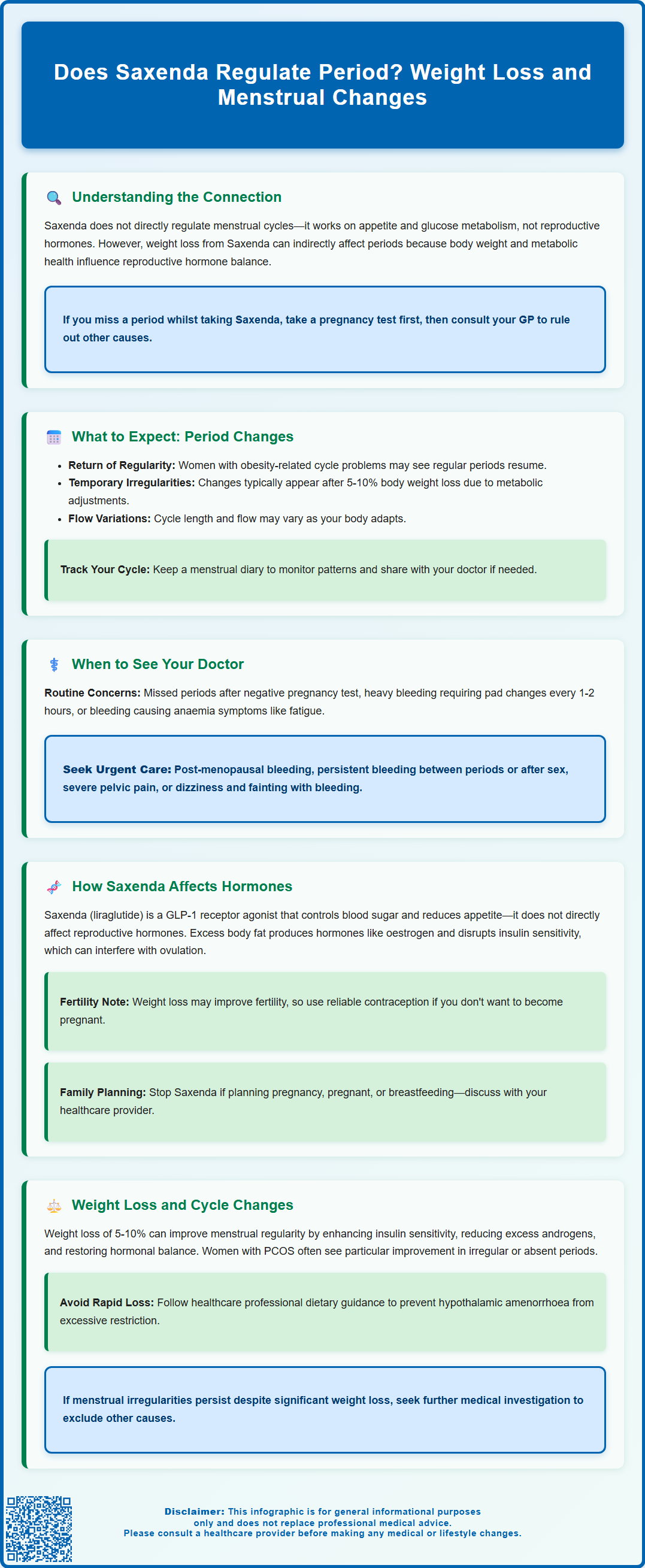Wegovy®
A weekly GLP-1 treatment proven to reduce hunger and support meaningful, long-term fat loss.
- ~16.9% average body weight loss
- Boosts metabolic & cardiovascular health
- Proven, long-established safety profile
- Weekly injection, easy to use

Many women taking Saxenda (liraglutide 3.0 mg) for weight management notice changes to their menstrual cycle and wonder whether the medication directly regulates periods. Saxenda is a GLP-1 receptor agonist licensed by the MHRA for obesity treatment, but it does not directly regulate menstruation and is not indicated for menstrual disorders. However, the weight loss achieved through Saxenda can indirectly influence menstrual patterns by improving metabolic health and hormonal balance. This article explores the connection between Saxenda, weight loss, and menstrual cycle changes, helping you understand what to expect and when to seek medical advice.
Summary: Saxenda does not directly regulate periods but weight loss from treatment may indirectly improve menstrual regularity through metabolic and hormonal changes.
Saxenda (liraglutide 3.0 mg) is a glucagon-like peptide-1 (GLP-1) receptor agonist licensed by the MHRA for weight management in adults with obesity or overweight with weight-related comorbidities. Many women taking Saxenda report changes to their menstrual cycle, leading to questions about whether the medication directly regulates periods. It is important to understand that Saxenda does not directly regulate the menstrual cycle and is not indicated for menstrual disorders — there is no official link between liraglutide and menstrual regulation in its pharmacological action.
However, the weight loss achieved through Saxenda treatment can indirectly influence menstrual patterns. Body weight, adipose tissue distribution, and metabolic health all play significant roles in reproductive hormone balance. Women with obesity often experience menstrual irregularities due to hormonal imbalances, insulin resistance, and conditions such as polycystic ovary syndrome (PCOS). When substantial weight loss occurs, the body's hormonal environment can shift, potentially leading to changes in menstrual regularity.
Key points to consider:
Saxenda works primarily on appetite regulation and glucose metabolism, not directly on reproductive hormones
Any menstrual changes are likely secondary to weight loss rather than a direct drug effect
Individual responses vary considerably based on baseline weight, metabolic health, and underlying conditions
Saxenda treatment involves weekly dose escalation to 3.0 mg daily, with treatment discontinued if at least 5% weight loss is not achieved after 12 weeks on the full dose
If you experience significant menstrual changes whilst taking Saxenda, it is advisable to discuss these with your GP or healthcare professional. If your period is late or missed, first take a pregnancy test. Your GP can assess whether any menstrual changes are related to weight loss, require investigation, or indicate an underlying condition requiring attention. Women with pre-existing menstrual disorders should inform their prescriber before starting Saxenda treatment.
Women taking Saxenda may experience various menstrual changes during their treatment journey, though these are not listed as adverse reactions in the UK Summary of Product Characteristics. The changes reported anecdotally by patients include alterations in cycle length, flow intensity, premenstrual symptoms, and timing of menstruation. Understanding what might occur can help you monitor your health appropriately.
Common menstrual changes associated with weight loss (which may occur during Saxenda treatment) include:
Return of regular cycles: Women with obesity-related amenorrhoea or oligomenorrhoea may find their periods become more regular as weight decreases
Temporary irregularity: Some women experience irregular cycles during the active weight loss phase, which typically stabilise once weight plateaus
Changes in flow: Menstrual bleeding may become lighter or heavier, though this varies individually
Altered cycle length: The time between periods may shorten or lengthen temporarily
These changes typically reflect the body's metabolic and hormonal adjustment to weight loss rather than a direct drug effect. The timeframe for experiencing menstrual changes varies — some women notice differences within the first few months, whilst others see changes only after significant weight loss (typically 5-10% of body weight or more).
When to seek medical advice:
Missed or absent periods – take a home pregnancy test first, then see your GP if negative
Heavy bleeding that impacts your quality of life, causes anaemia symptoms (fatigue, shortness of breath), or requires frequent pad/tampon changes (every 1-2 hours)
Any bleeding after menopause (urgent 2-week referral)
Persistent bleeding between periods or after intercourse
Severe pelvic pain accompanying menstrual changes
Symptoms of haemodynamic instability (dizziness, fainting) with bleeding (seek urgent care)
Your GP may recommend investigations such as hormone profiles, pelvic ultrasound, or thyroid function tests if menstrual changes are concerning or persistent. Keep a menstrual diary to help identify patterns and facilitate clinical assessment. Ensure your cervical screening is up to date.

Understanding Saxenda's mechanism of action helps clarify why menstrual changes might occur during treatment. Liraglutide is a GLP-1 receptor agonist that mimics the action of naturally occurring glucagon-like peptide-1, an incretin hormone produced in the intestine. Its primary actions include enhancing glucose-dependent insulin secretion, suppressing inappropriate glucagon release, slowing gastric emptying, and reducing appetite through effects on brain appetite centres.
Saxenda does not directly target reproductive hormones such as oestrogen, progesterone, luteinising hormone (LH), or follicle-stimulating hormone (FSH). However, the metabolic improvements and weight loss it facilitates can indirectly influence the hormonal environment that regulates menstruation. Adipose tissue is metabolically active and produces hormones including leptin, adiponectin, and oestrogen through aromatisation of androgens. In obesity, excess adipose tissue can lead to:
Elevated oestrogen levels from peripheral conversion
Insulin resistance affecting ovarian function
Increased androgens contributing to anovulation
Disrupted hypothalamic-pituitary-ovarian axis signalling
As weight decreases with Saxenda treatment, these metabolic disturbances may improve. Insulin sensitivity typically enhances, which can restore normal ovarian function in women with PCOS or metabolic syndrome. The reduction in adipose tissue decreases peripheral oestrogen production, potentially normalising the oestrogen-to-progesterone ratio.
Clinical considerations:
Women of reproductive age should be aware that improved fertility may accompany weight loss. If you do not wish to conceive, ensure adequate contraception is in place. Saxenda has no clinically relevant effect on the exposure of combined oral contraceptives. Saxenda should not be used during pregnancy, and treatment should be discontinued if planning pregnancy or if pregnancy occurs. Saxenda is not recommended during breastfeeding. Discuss family planning with your healthcare professional when starting Saxenda treatment.
If you experience any suspected side effects from Saxenda, report them via the MHRA Yellow Card scheme (yellowcard.mhra.gov.uk).
The relationship between weight loss and menstrual cycle regulation is well-established in medical literature, regardless of the method used to achieve weight reduction. Weight management can improve reproductive health outcomes in women with obesity, particularly those with PCOS or fertility concerns. Saxenda-induced weight loss follows similar patterns to weight loss achieved through other means, with comparable effects on menstrual health.
Clinical evidence suggests that even modest weight loss of 5-10% of body weight can improve menstrual regularity in women with obesity-related menstrual dysfunction. The mechanisms include improved insulin sensitivity, reduced hyperandrogenism, normalisation of leptin levels, and restoration of hypothalamic-pituitary-ovarian axis function. Women with PCOS, who frequently experience oligomenorrhoea or amenorrhoea, often see particular benefit from weight reduction.
Factors influencing menstrual response to weight loss:
Baseline BMI: Women with higher starting BMI may require greater absolute weight loss before menstrual changes occur
Rate of weight loss: Very rapid or extreme weight loss may disrupt cycles through stress responses
Underlying conditions: Pre-existing PCOS, thyroid disorders, or hypothalamic amenorrhoea influence response
Age and reproductive stage: Perimenopausal women may experience different patterns
It is important to maintain realistic expectations. Whilst many women experience improved menstrual regularity with weight loss, Saxenda is not a treatment for menstrual disorders. Women with diagnosed conditions such as PCOS, endometriosis, or fibroids should continue appropriate specialist care alongside weight management. If menstrual irregularities persist despite significant weight loss, further investigation may be warranted to exclude other causes.
Excessive calorie restriction during Saxenda treatment could potentially lead to hypothalamic amenorrhoea, so follow dietary guidance from your healthcare professional. Remember that Saxenda treatment involves weekly dose escalation to 3.0 mg daily, with treatment discontinued if at least 5% weight loss is not achieved after 12 weeks on the full dose.
Your GP can help monitor your progress and determine whether menstrual changes are appropriate responses to weight loss or require additional assessment. Regular follow-up appointments during Saxenda treatment provide opportunities to discuss any concerns about menstrual health and overall wellbeing.
Saxenda does not directly affect menstruation, but the weight loss it facilitates can indirectly influence menstrual patterns through improved metabolic health and hormonal balance. Women may experience more regular cycles, temporary irregularity during active weight loss, or changes in flow.
Consult your GP if you experience missed periods (after a negative pregnancy test), heavy bleeding affecting quality of life, bleeding between periods or after intercourse, severe pelvic pain, or any postmenopausal bleeding. Your GP can assess whether changes require investigation.
Weight loss from Saxenda may improve fertility in women with obesity-related reproductive issues, so ensure adequate contraception if you do not wish to conceive. Saxenda does not affect combined oral contraceptive exposure and should be discontinued if pregnancy occurs or is planned.
The health-related content published on this site is based on credible scientific sources and is periodically reviewed to ensure accuracy and relevance. Although we aim to reflect the most current medical knowledge, the material is meant for general education and awareness only.
The information on this site is not a substitute for professional medical advice. For any health concerns, please speak with a qualified medical professional. By using this information, you acknowledge responsibility for any decisions made and understand we are not liable for any consequences that may result.
Lorem ipsum dolor sit amet, consectetur adipiscing elit, sed do eiusmod tempor incididunt ut labore et dolore magna aliqua. Ut enim ad minim veniam, quis nostrud exercitation ullamco laboris nisi ut aliquip ex ea commodo consequat. Duis aute irure dolor in reprehenderit in voluptate velit esse cillum dolore eu fugiat nulla pariatur.
Block quote
Ordered list
Unordered list
Bold text
Emphasis
Superscript
Subscript